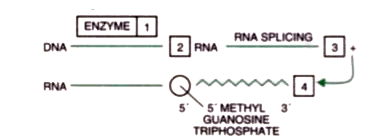The correct sequence of different steps of polymerease chain reaction is
1) annealing
→
denaturation
→
extension
2) denaturation
→
extension
→
annealing
3) denaturation
→
annealing
→
extension
4) extension
→
denaturation
→
annealing
1) annealing → denaturation → extension
2) denaturation → extension → annealing
3) denaturation → annealing → extension
4) extension → denaturation → annealing
The correct Answer is:C
To solve the question regarding the correct sequence of steps in the Polymerase Chain Reaction (PCR), we can follow these steps:
1. Identify the Steps of PCR:
The three main steps in the PCR process are:
- Denaturation: The double-stranded DNA is heated to separate it into two single strands.
- Annealing: Primers bind to the single-stranded DNA at specific locations.
- Extension: DNA polymerase synthesizes new DNA strands by adding nucleotides to the primers.
2. Determine the Correct Sequence:
- The first step is Denaturation where the DNA strands are separated.
- The second step is Annealing where the primers attach to the single-stranded DNA.
- The third step is Extension where the new DNA strands are synthesized.
3. Match with Given Options:
- Option 1: Annealing → Denaturation → Extension (Incorrect)
- Option 2: Denaturation → Extension → Annealing (Incorrect)
- Option 3: Denaturation → Annealing → Extension (Correct)
- Option 4: Extension → Denaturation → Annealing (Incorrect)
4. Conclusion:
The correct sequence of steps in PCR is Denaturation → Annealing → Extension, which corresponds to Option 3.
Final Answer:
The correct sequence of different steps of polymerase chain reaction is Option 3: Denaturation → Annealing → Extension.
The three main steps in the PCR process are:
- Denaturation: The double-stranded DNA is heated to separate it into two single strands.
- Annealing: Primers bind to the single-stranded DNA at specific locations.
- Extension: DNA polymerase synthesizes new DNA strands by adding nucleotides to the primers.
- The first step is Denaturation where the DNA strands are separated.
- The second step is Annealing where the primers attach to the single-stranded DNA.
- The third step is Extension where the new DNA strands are synthesized.
- Option 1: Annealing → Denaturation → Extension (Incorrect)
- Option 2: Denaturation → Extension → Annealing (Incorrect)
- Option 3: Denaturation → Annealing → Extension (Correct)
- Option 4: Extension → Denaturation → Annealing (Incorrect)
The correct sequence of steps in PCR is Denaturation → Annealing → Extension, which corresponds to Option 3.
The correct sequence of different steps of polymerase chain reaction is Option 3: Denaturation → Annealing → Extension.
Topper's Solved these Questions
- BIOTECHNOLOGY - PRINCIPLES AND PROCESSESBook:NCERT FINGERTPS ENGLISHChapter:BIOTECHNOLOGY - PRINCIPLES AND PROCESSESExercise:HOTS
Explore 5 Videos
- BIOTECHNOLOGY - PRINCIPLES AND PROCESSESBook:NCERT FINGERTPS ENGLISHChapter:BIOTECHNOLOGY - PRINCIPLES AND PROCESSESExercise:NCERT
Explore 19 Videos
- BIODIVERSITY & CONSERVATIONBook:NCERT FINGERTPS ENGLISHChapter:BIODIVERSITY & CONSERVATIONExercise:Biodiversity & Conservation
Explore 140 Videos
- BIOTECHNOLOGY AND ITS APPLICATIONBook:NCERT FINGERTPS ENGLISHChapter:BIOTECHNOLOGY AND ITS APPLICATIONExercise:Biotechnology And Its Application
Explore 137 Videos
Similar Questions
Select the correct sequence of steps involved in PCR during gene amplification.
(a) Denaturation , annealing , extension
(b) Denaturation , extension , annealing
(c) Extension , Denaturation, Annealing
(d) Annealing , extension , denaturation
View SolutionStatement-1 : Entropy of egg increases after boiling.
And
Statement-2 : As boiling causes the denaturation of proteins.
View Solution
Knowledge Check
The polymerase chain reaction is a technique used for
1) amplification of DNA
2) amplification of enzymes
3) amplification of proteins
4) all of theseA1) amplification of DNAB2) amplification of enzymesC3) amplification of proteinsD4) all of theseWhich of the following steps are catalysed by Taq polymerase in a PCR reaction ?
(a) Denaturation of template DNA
(b) Annealing of primers to template DNA
(c) Extension of primer and on the template DNA
(d) All of the aboveADenaturation of template DNABAnnealing of primers to template DNACExtension of primer and on the template DNADAll of the above
Denaturation is a step in the procedure called polymerase chain Reaction . This step does not involve which of the following process ?
View SolutionGiven below is a sequence of steps of transcription in a eukaryotic cell. Fill up the blanks (1,2,3,4) left in the sequence .

View SolutionIn a polymerase chain reaction after the denaturation step why the mixture needs to cool down to a lower temperature ?
a) To permit specific annealing of the primers
b) To give a halt to the reaction mixture
c) To increase the activity of enzyme Taq polymerase
d) To obtain the multiple copies of the DNA
View SolutionWhich of the statements about ''Denaturation'' given below are correct ?
(1) Denaturation of proteins causes loss of secondary and tertiary structures of the protein.
(2) Denaturation leads to the conversion of double strand of DNA into single strand.
(3) Denaturation affects primary structure which gets distorted.
View SolutionTwo wire mode of the same material are subjected to force in the ratio of 1:2. Their lengths are in the ratio 8:1 and diameters in the raio 2:1. Find the ratio of their extension.
View SolutionGiven below is a sequence of steps of transcription in a eukaryotic cell. Fill up the blanks (1, 2, 3, 4) left in the sequence.

View Solution

